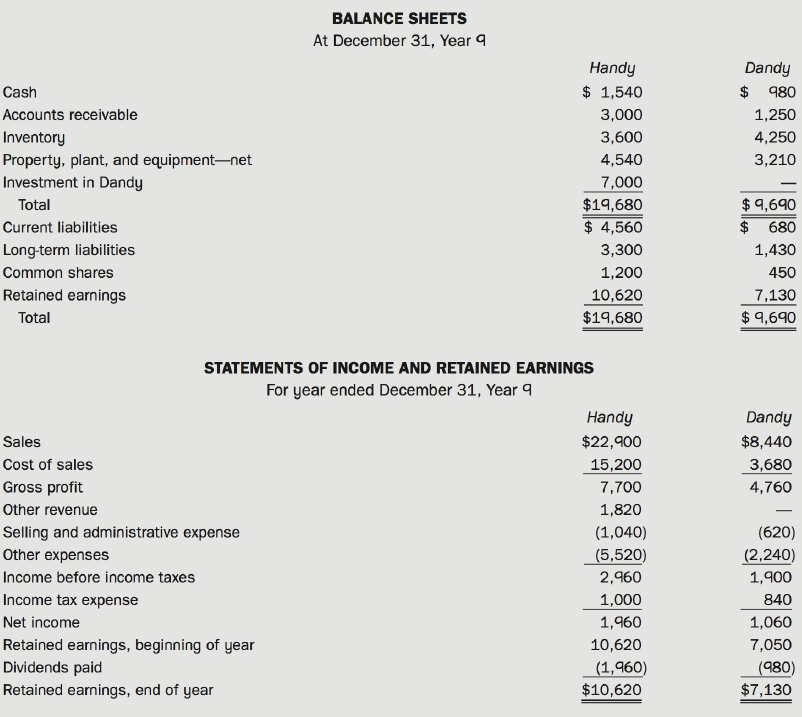On January 1, Year 4, Handy Company (Handy) purchased 70% of the outstanding common shares of Dandy
Question:
On January 1, Year 4, Handy Company (Handy) purchased 70% of the outstanding common shares of Dandy Limited (Dandy) for $13,300. On that date, Dandy's shareholders' equity consisted of common shares of $1,250 and retained earnings of $6,500.
The financial statements for Handy and Dandy for Year 9 were as follows:

Additional Information:
• In negotiating the purchase price at the date of acquisition, it was agreed that the fair values of all of Dandy's assets and liabilities were equal to their carrying amounts, except for the following:

• Both companies use FIFO to account for their inventory and the straight-line method for amortizing their property, plant, and equipment. Dandy's equipment had a remaining useful life of 10 years at the acquisition date.
• Goodwill is not amortized on a systematic basis. However, each year, goodwill is evaluated to determine if there has been a permanent impairment. It was determined that goodwill on the consolidated balance sheet should be reported at its recoverable amount of $1,300 on December 31, Year 8, and $1,220 on December 31, Year 9.
• During Year 9, inventory sales from Dandy to Handy were $5,900. Handy's inventories contained merchandise purchased from Dandy for $3,400 at December 31, Year 8, and $4,500 at December 31, Year 9. Dandy earns a gross margin of 50% on its intercompany sales.
• On January 1, Year 5, Handy sold some equipment to Dandy for $3,000 and recorded a gain of $360 before taxes. This equipment had a remaining useful life of eight years at the time of the purchase by Dandy.
• Handy charges $50 per month to Dandy for consulting services and has been doing so throughout Years 8 and 9.
• Handy uses the cost method of accounting for its long-term investment.
• Both companies pay taxes at the rate of 40%.
• Amortization expense is grouped with production expenses, and impairment losses are grouped with other expenses.
Required:
(a) Prepare a consolidated statement of income for the year ended December 31, Year 9. Show supporting calculations.
(b) Calculate consolidated retained earnings at January 1, Year 9, and then prepare a consolidated statement of retained earnings for the year ended December 31, Year 9. Show supporting calculations.
(c) Explain how the historical cost principle supports the adjustments made on consolidation when there has been an intercompany sale of equipment.
(d) Calculate goodwill impairment loss and non-controlling interest on the consolidated income statement for the year ended December 31, Year 9, under the parent company extension theory.
(e) Prepare the consolidated financial statements using the worksheet approach.
GoodwillGoodwill is an important concept and terminology in accounting which means good reputation. The word goodwill is used at various places in accounting but it is recognized only at the time of a business combination. There are generally two types of... Financial Statements
Financial statements are the standardized formats to present the financial information related to a business or an organization for its users. Financial statements contain the historical information as well as current period’s financial... Consolidated Income Statement
When talking about the group financial statements the consolidated financial statements include Consolidated Income Statement that a parent must prepare among other sets of consolidated financial statements. Consolidated Income statement that is...
Step by Step Answer:

Modern Advanced Accounting in Canada
ISBN: 978-1259087554
8th edition
Authors: Hilton Murray, Herauf Darrell





